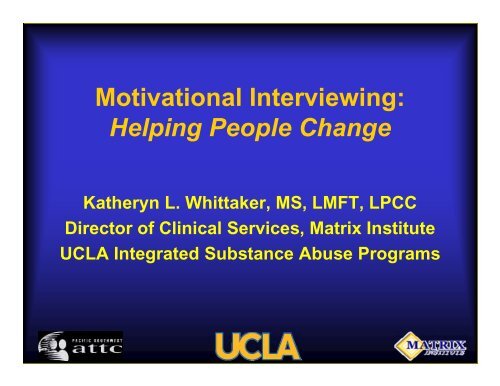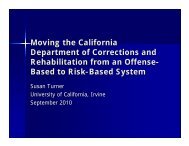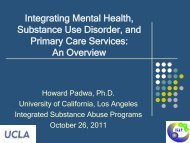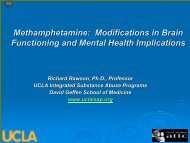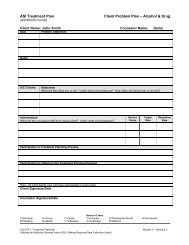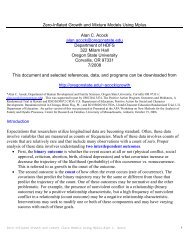Motivational Interviewing: Helping People Change - UCLA ...
Motivational Interviewing: Helping People Change - UCLA ...
Motivational Interviewing: Helping People Change - UCLA ...
Create successful ePaper yourself
Turn your PDF publications into a flip-book with our unique Google optimized e-Paper software.
<strong>Motivational</strong> <strong>Interviewing</strong>:<br />
<strong>Helping</strong> <strong>People</strong> <strong>Change</strong><br />
Katheryn L. Whittaker, MS, LMFT, LPCC<br />
Director of Clinical Services, Matrix Institute<br />
<strong>UCLA</strong> Integrated Substance Abuse Programs
What is <strong>Motivational</strong><br />
<strong>Interviewing</strong>?<br />
A style of talking with people<br />
constructively about reducing their<br />
health risks and changing their<br />
behavior.
What is <strong>Motivational</strong><br />
<strong>Interviewing</strong>?<br />
It is designed to:<br />
Enhance the client’s own motivation to<br />
change using strategies that are<br />
empathic and non-confrontational.
Traditional Approach<br />
• <strong>Change</strong> is motivated by discomfort<br />
• If you can make people feel bad enough, they<br />
will change.<br />
• <strong>People</strong> have to “hit bottom” to be ready for<br />
change<br />
• <strong>People</strong> don’t change if they haven’t suffered<br />
enough<br />
• Someone who continues to use is “in denial.”<br />
• The best way to “break through” the denial is<br />
direct confrontation.
What is <strong>Motivational</strong><br />
<strong>Interviewing</strong>?<br />
It can be defined as:<br />
A client-centered directive method for<br />
enhancing intrinsic motivation to change<br />
by exploring and resolving ambivalence.
How does MI differ from traditional or<br />
typical traditional counseling?<br />
1. Client and practitioner are equal<br />
partners in relationship (collaborative<br />
effort between two experts)
How does MI differ from<br />
traditional counseling?<br />
• <strong>People</strong> are almost always ambivalent about<br />
change – ambivalence is normal<br />
• Lack of motivation can be viewed as<br />
unresolved ambivalence.
How does MI differ from<br />
traditional counseling?<br />
• AMBIVALENCE is the key issue to be<br />
resolved for change to occur.<br />
• <strong>People</strong> are more likely to change when they<br />
hear their own discussion of their ambivalence.<br />
• This discussion is called “change talk”<br />
in MI.<br />
• Getting clients to engage in “change talk” is a<br />
critical element of the MI process.<br />
*Glovsky and Rose, 2008
How do we decide if a person is<br />
“Motivated”<br />
•The person agrees with us<br />
•Is willing to comply with our recommendations<br />
and treatment prescriptions<br />
•States desire for help<br />
•Shows distress, acknowledges helplessness<br />
•Has a successful outcome
<strong>Motivational</strong> <strong>Interviewing</strong>,<br />
2 nd Edition.<br />
Miller and Rollnick<br />
• This second edition of the book, <strong>Motivational</strong><br />
<strong>Interviewing</strong>, deals with changing health-related<br />
behaviors in general.<br />
• Another useful resource is TIP 35, (Enhancing<br />
Motivation for <strong>Change</strong> in Substance Abuse<br />
Treatment) published by the Center for Substance<br />
Abuse Treatment (CSAT) and available online at<br />
http://text.nlm.nih.gov
Four Principles of<br />
<strong>Motivational</strong> <strong>Interviewing</strong><br />
(What you are actually doing)<br />
1. Expressing empathy<br />
2. Developing discrepancy<br />
3. Avoiding argumentation<br />
4. Supporting self-efficacy
1. Express Empathy<br />
•Acceptance facilitates change<br />
•Skillful reflective listening is fundamental<br />
•Ambivalence is normal
2. Develop Discrepancy<br />
•Discrepancy between present behaviors and<br />
important goals or values motivates change<br />
•Awareness of consequences is important<br />
•Goal is to have the PERSON present reasons<br />
for change
Decisional Balance<br />
The good<br />
things<br />
about<br />
______<br />
The notso-good<br />
things<br />
about ____<br />
The good<br />
things<br />
about<br />
changing<br />
The not-sogood<br />
things<br />
about<br />
changing
3. Avoid Argumentation<br />
•Resistance is signal to change strategies<br />
•Labeling is unnecessary<br />
•Shift perceptions<br />
•<strong>People</strong>s’ attitudes shaped by their words,<br />
not yours
4. Support Self-Efficacy<br />
• Belief that change is possible is<br />
important motivator<br />
• Person is responsible for choosing and<br />
carrying out actions to change<br />
• There is hope in the range of<br />
alternative approaches available
Stages of <strong>Change</strong><br />
Prochaska & DiClemente
Precontemplation Stage<br />
• Definition<br />
Not yet considering change or is<br />
unwilling or unable to change<br />
• Primary task<br />
Raising Awareness
Some Ways to Raise Awareness<br />
in the Precontemplation Stage<br />
• Offer factual information<br />
• Explore the meaning of events that<br />
brought the person in and the results of<br />
previous efforts<br />
• Explore pros and cons of targeted<br />
behaviors
Contemplation Stage<br />
• In this stage the client sees the<br />
possibility of change but is ambivalent<br />
and uncertain about beginning the<br />
process<br />
• Primary task<br />
Resolving ambivalence and helping the<br />
client choose to make the change
Possible Ways to Help the Patient in<br />
the Contemplation Stage<br />
• Talk about the person’s sense of selfefficacy<br />
and expectations regarding<br />
what the change will entail<br />
• Summarize self-motivational<br />
statements<br />
• Continue exploration of pros and cons
Preparation Stage<br />
• In this stage the client is committed to<br />
changing but is still considering exactly<br />
what to do and how to do<br />
• Primary task<br />
Help client identify appropriate change<br />
strategies
Possible Ways to Help the Patient in<br />
the Preparation Stage<br />
• Offer a menu of options for change or<br />
treatment<br />
• Help client identify pros and cons of various<br />
treatment or change options<br />
• Identify and lower barriers to change<br />
• Help person enlist social support<br />
• Encourage person to publicly announce<br />
plans to change
Action Stage<br />
• In this stage the client is taking steps<br />
toward change but hasn’t stabilized in<br />
the process<br />
• Primary task<br />
Help implement the change strategies<br />
and learn to limit or eliminate potential<br />
relapses
Possible Ways to Help the Client<br />
in the Action Stage<br />
• Support a realistic view of change through<br />
small steps<br />
• Help person identify high-risk situations<br />
and develop appropriate coping strategies<br />
• Assist person in finding new reinforcers of<br />
positive change<br />
• Help access family and social support
How Can I Help Client’s<br />
Move through This <strong>Change</strong> Process?<br />
• Use the microskills<br />
– Open-ended questions<br />
– Affirmations<br />
– Reflections<br />
– Summaries<br />
to elicit and reinforce self-motivational<br />
statements (<strong>Change</strong> Talk)
Building Motivation using<br />
OARS (the microskills)<br />
• Open-ended questioning<br />
• Affirming<br />
• Reflective listening<br />
• Summarizing
Open-ended Questions<br />
• An open-ended question is one with more than<br />
a yes or no response<br />
• Helps person elaborate own view of the problem<br />
and brainstorm possible solutions
Affirmations<br />
• Focused on achievements of individual<br />
• Intended to:<br />
– Support person’s persistence<br />
– Encourage continued efforts<br />
– Assist person in seeing positives<br />
– Support individual’s proven strengths
Reflective Listening<br />
Key-concepts<br />
• Listen to both what the person says and to what<br />
the person means<br />
• Check out assumptions<br />
• Create an environment of empathy<br />
(nonjudgmental)<br />
• You do not have to agree<br />
• Be aware of intonation (statement, not<br />
question)
Levels of Reflection<br />
• Level 1: Repeat<br />
• These reflections add nothing at all to<br />
what the client had said, but simply<br />
repeat or restate using some of all of<br />
the same words.
Levels of Reflection (cont)<br />
• Level 2: Rephrase<br />
• This reflection stays close to what the<br />
client had said, but slightly rephrases it,<br />
usually by substituting a synonym. It is<br />
the same thing said by the client, but in<br />
a slightly different way.
Levels of Reflection - (cont)<br />
• Level 3: Paraphrase<br />
• These reflections change or add to what<br />
the client has said in a significant way,<br />
to infer the client’s meaning. The<br />
therapist is saying something that the<br />
client has not yet stated directly.
Level 3: Paraphrase -(cont)<br />
• Continuing the Paragraph – the therapist<br />
anticipates the next statement that has not<br />
yet been expressed by the client.<br />
• Amplified Reflection – the content offered<br />
by the client is exaggerated, increased in<br />
intensity, overstated, or otherwise reflected<br />
in a manner that amplifies it.
Level 3: Paraphrase - (cont)<br />
• Double-Sided Reflection – both sides of<br />
ambivalence are contained in a single<br />
reflective response.<br />
• Metaphor and Simile – can be used as a<br />
reflection.<br />
• Reflection of Feelings – reflecting a<br />
feeling that was not specifically verbalized<br />
by the client.
SUMMARIZING<br />
•Summaries capture both sides of the ambivalence<br />
(You say that ___________ but you also<br />
mentioned that ________________.)<br />
•Summaries also prompt clarification and further<br />
elaboration from the person.
Four Foundational Processes<br />
ENGAGE the client<br />
FOCUS on specific change<br />
to be made<br />
EVOKE change talk<br />
(DARN C)<br />
PLAN steps for<br />
change
Focusing<br />
• Developing a clear direction and goal(s)<br />
• Sometimes the goal is clear; often it is<br />
not.
Evoke<br />
• Pulling for <strong>Change</strong> Talk<br />
• Happens after engaging the client and<br />
making the determination re: what exact<br />
change will be the focus.<br />
• Continues to happen during the<br />
planning stage.
What is <strong>Change</strong> Talk?<br />
DARN - C<br />
A statement that indicates a person’s<br />
Desire to<br />
change<br />
Ability to<br />
change<br />
Reasons to<br />
change<br />
Need for<br />
change<br />
Commitment Language is stronger than <strong>Change</strong> Talk<br />
Indicates an intention to change. (I will, I am going to, etc.)
<strong>Change</strong> Talk also looks like this<br />
Problem<br />
Recognition<br />
Concern<br />
about the<br />
Problem<br />
Awareness<br />
of the<br />
Problem<br />
Potential<br />
Benefits of<br />
<strong>Change</strong><br />
Costs of Not<br />
Changing
The Objective<br />
<strong>Motivational</strong><br />
<strong>Interviewing</strong><br />
<strong>Change</strong> Talk<br />
Commitment<br />
Language<br />
Taking Steps<br />
to <strong>Change</strong>
kwhittaker@matrixinstitute.org<br />
www.matrixinstitute.org<br />
www. uclaisap.org<br />
http://motivationalinterview.org<br />
Miller, W.R., & Rollnick, S. (2002). <strong>Motivational</strong> <strong>Interviewing</strong>: Preparing<br />
<strong>People</strong> for <strong>Change</strong> (2 nd Ed). New York: Guilford Press.


